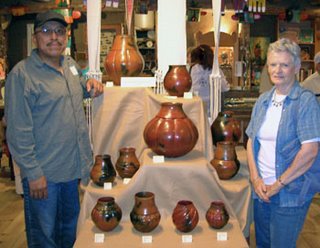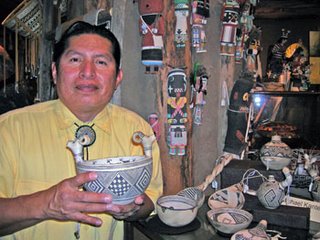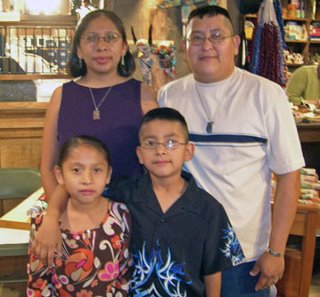Arguably, the museums on Museum Hill in Santa Fe represent the most impressive nexus of Native American Indian culture and art in the world. Granted, I have not visited the Smithsonian in recent years, and I have long admired the Heye Collection.
Susanne’s and my visit to Museum Hill yesterday, however, turned my opinion towards the Museum of Indian Arts and Culture and the Wheelwright Museum of the American Indian, both of which share the Hill with the International Folk Art Museum. The Wheelwright, a private museum, currently hosts a primary exhibit entitled, “The First Phase: Early Navajo Textiles and Silver.” It features serapes, blankets and rugs by historic and contemporary Navajo weavers, and relates how Navajo artists evolved into silver-smithing as a result of loosing their sheep and wool resources in the 1800s.
One of the most interesting aspects of the exhibition, from our perspective, is the fairly comprehensive definition of First Phase, Second Phase and Third Phase “Chief’s Blankets”. Experts suggest that the label, “Chief’s Blankets”, never referred to them as blankets made to be worn by Navajo chiefs. More likely, they say, is that the “Chief’s Blanket” designs became the preferred design in trade with Plains Indian chiefs. Another theory is more mundane. It suggests that the term was a promotional creation, prominently used by the Hubbell Trading Post, to add additional romance to the Navajo textiles it was selling.
Nevertheless, "Chief's Blankets" have distinctive styles according to the time periods during which they were woven. First Phase blankets are more basic in design, usually featuring horizontal stripes in natural, indigo and white. Second Phase blankets become more complicated in design with the addition of red yarn and complex patterns. Third Phase blankets are characterized by corner designs that appear coordinatedwhen the blanket is worn over the shoulders and folded in a certain way.
(Navajo weaving and silver-smithing is closely tied to the poor treatment the tribal members received at the hands of the US government during their removal to the Bosque Redondo. This subject deserves more discussion than can be given here. But it should not be ignored completely whenever one is reflecting about the evolution of Navajo material culture.)
This informative show resides above one of Santa Fe’s most impressive Indian Art salesrooms; The Case Trading Post. We have always enjoyed the Case, especially the old wood floor that would squeak as you walked across it. Today’s experience was different. The crowd was so large that the old wood floor was beyond its ability to squeak. They were attracted by the Navajo textiles and silver show and by the presence of artists “in residence” in the Case, representing their work to enthusiastic fans and buyers.
 Alicia Nelson was there, weaving Navajo baskets of extraordinary detail and finesse. (She requested that we not photograph the baskets.)
Alicia Nelson was there, weaving Navajo baskets of extraordinary detail and finesse. (She requested that we not photograph the baskets.)
 In the Trading Post retail area, we found Samuel Manymules, (shown here with
In the Trading Post retail area, we found Samuel Manymules, (shown here with
Susanne and examples of his work) whose pots have been re-defining beauty
and quality in Navajo pottery. Examples also are offered at Native PotteryLink.
 Michael Kanteena also was present, showing his unique work in
Michael Kanteena also was present, showing his unique work in
Laguna Pueblo pottery that emulates historic and prehistoric looks.
You'll find a nice example here.


We also noted that Kent McManis has a new book on fetish carving that will be offered at an autograph signing session tomorrow. Kent is an unchallenged authority on the subject. We first worked with him when he was the manager of Sandia Pueblo’s Bien Mur store. We still consider him a friend and value that association.
From the Wheelwright, we moved to the Museum of Indian Arts and Culture. This New Mexico state museum has remarkably informative and thorough exhibits of Native American art from the Southwest: pottery, textiles, baskets, jewelry, history and living.
One gallery has a comprehensive display of Pueblo pottery, explaining differences in style and form, from every Rio Grande pueblo. An entire room was devoted to a temporary exhibit of Santa Ana Pueblo pottery.
Another impressive exhibit explores and explains the history of Native American culture from the B.C. through current times. “Here, Now & Always”, starts with the Mogollon, Hohokam and early Pueblo communities, from the pithouse dwellers to the builders of cliff cities in Mesa Verde and other places in the Southwest. It travels in time to contemporary Indian life - the garments, pottery, basketry, foods and housing – explaining their relationship to the traditions of hunting, farming and family raising, by Indian men and women over the centuries.
Two quotes among the many on the walls struck as particularly poignant. “Pueblo people believe that clay has life. A sacred relationship between the potter and clay begins when the clay is taken from the earth. Before removing the clay, the potter prays to Earth Clay Old lady to be considerate of the needs of her family” is quoted from Santa Clara Pueblo member, Tessie Naranjo. Does this relationship with the infinite have something to do with the way Pueblo pottery reaches out to each of us when we encounter it? We think so.
A second observation that resonated with us was the absence of a word for “art” in Indian language. The exhibit asks the question, can you call something “art” that is part of your life, with soul and spiritual purpose in addition to its functionality? Perhaps, but only secondarily. It reminded us of our long-standing motto at Aboriginals : Art of the First Person - “Before it was art, it was life.” If you ever are in Santa Fe, don’t leave with dedicating a day to the Wheelwright and Museum of Indian Arts and Culture.
If you stop for a bit of respite, try the Museum Hill café, on the Museum plaza. It proffers a nice selection of sandwiches, soups and beverages (even wine), and an inviting terrace on which to enjoy them. As we sat there, alternately sipping gazpacho and wine, a panoramic cloudscape, almost threatening in its apparent force, made an appearance of the horizon's stage.
Then we noted a huge statue, appearing to represent an Apache Gann dancer, constructed on the plaza. The cloud-scape seemed to become a fitting background for its powerful presence. A power that was beyond the scope even of our meager digital camera.

Visits to Santa Fe seem to be filled with such compelling combinations of the sublime and the awesome.
Susanne’s and my visit to Museum Hill yesterday, however, turned my opinion towards the Museum of Indian Arts and Culture and the Wheelwright Museum of the American Indian, both of which share the Hill with the International Folk Art Museum. The Wheelwright, a private museum, currently hosts a primary exhibit entitled, “The First Phase: Early Navajo Textiles and Silver.” It features serapes, blankets and rugs by historic and contemporary Navajo weavers, and relates how Navajo artists evolved into silver-smithing as a result of loosing their sheep and wool resources in the 1800s.
One of the most interesting aspects of the exhibition, from our perspective, is the fairly comprehensive definition of First Phase, Second Phase and Third Phase “Chief’s Blankets”. Experts suggest that the label, “Chief’s Blankets”, never referred to them as blankets made to be worn by Navajo chiefs. More likely, they say, is that the “Chief’s Blanket” designs became the preferred design in trade with Plains Indian chiefs. Another theory is more mundane. It suggests that the term was a promotional creation, prominently used by the Hubbell Trading Post, to add additional romance to the Navajo textiles it was selling.
Nevertheless, "Chief's Blankets" have distinctive styles according to the time periods during which they were woven. First Phase blankets are more basic in design, usually featuring horizontal stripes in natural, indigo and white. Second Phase blankets become more complicated in design with the addition of red yarn and complex patterns. Third Phase blankets are characterized by corner designs that appear coordinatedwhen the blanket is worn over the shoulders and folded in a certain way.
(Navajo weaving and silver-smithing is closely tied to the poor treatment the tribal members received at the hands of the US government during their removal to the Bosque Redondo. This subject deserves more discussion than can be given here. But it should not be ignored completely whenever one is reflecting about the evolution of Navajo material culture.)
This informative show resides above one of Santa Fe’s most impressive Indian Art salesrooms; The Case Trading Post. We have always enjoyed the Case, especially the old wood floor that would squeak as you walked across it. Today’s experience was different. The crowd was so large that the old wood floor was beyond its ability to squeak. They were attracted by the Navajo textiles and silver show and by the presence of artists “in residence” in the Case, representing their work to enthusiastic fans and buyers.
Elizabeth Manygoats was working there, in the artist’s corner,
creating her distinctive Navajo pottery.
creating her distinctive Navajo pottery.
 Alicia Nelson was there, weaving Navajo baskets of extraordinary detail and finesse. (She requested that we not photograph the baskets.)
Alicia Nelson was there, weaving Navajo baskets of extraordinary detail and finesse. (She requested that we not photograph the baskets.) In the Trading Post retail area, we found Samuel Manymules, (shown here with
In the Trading Post retail area, we found Samuel Manymules, (shown here withSusanne and examples of his work) whose pots have been re-defining beauty
and quality in Navajo pottery. Examples also are offered at Native PotteryLink.
 Michael Kanteena also was present, showing his unique work in
Michael Kanteena also was present, showing his unique work inLaguna Pueblo pottery that emulates historic and prehistoric looks.
You'll find a nice example here.

We also met for the first time Orlan Honyumptewa, Hopi katsina carver, and his family, including his young son, Trevor, who is starting his own carving career.

Fabian Tsethlikai was also present with a selection his Zuni fetish carvings.
Fabian’s work is included in pieces on our ZuniLink web site.
Fabian’s work is included in pieces on our ZuniLink web site.
We also noted that Kent McManis has a new book on fetish carving that will be offered at an autograph signing session tomorrow. Kent is an unchallenged authority on the subject. We first worked with him when he was the manager of Sandia Pueblo’s Bien Mur store. We still consider him a friend and value that association.
From the Wheelwright, we moved to the Museum of Indian Arts and Culture. This New Mexico state museum has remarkably informative and thorough exhibits of Native American art from the Southwest: pottery, textiles, baskets, jewelry, history and living.
One gallery has a comprehensive display of Pueblo pottery, explaining differences in style and form, from every Rio Grande pueblo. An entire room was devoted to a temporary exhibit of Santa Ana Pueblo pottery.
Another impressive exhibit explores and explains the history of Native American culture from the B.C. through current times. “Here, Now & Always”, starts with the Mogollon, Hohokam and early Pueblo communities, from the pithouse dwellers to the builders of cliff cities in Mesa Verde and other places in the Southwest. It travels in time to contemporary Indian life - the garments, pottery, basketry, foods and housing – explaining their relationship to the traditions of hunting, farming and family raising, by Indian men and women over the centuries.
Two quotes among the many on the walls struck as particularly poignant. “Pueblo people believe that clay has life. A sacred relationship between the potter and clay begins when the clay is taken from the earth. Before removing the clay, the potter prays to Earth Clay Old lady to be considerate of the needs of her family” is quoted from Santa Clara Pueblo member, Tessie Naranjo. Does this relationship with the infinite have something to do with the way Pueblo pottery reaches out to each of us when we encounter it? We think so.
A second observation that resonated with us was the absence of a word for “art” in Indian language. The exhibit asks the question, can you call something “art” that is part of your life, with soul and spiritual purpose in addition to its functionality? Perhaps, but only secondarily. It reminded us of our long-standing motto at Aboriginals : Art of the First Person - “Before it was art, it was life.” If you ever are in Santa Fe, don’t leave with dedicating a day to the Wheelwright and Museum of Indian Arts and Culture.
If you stop for a bit of respite, try the Museum Hill café, on the Museum plaza. It proffers a nice selection of sandwiches, soups and beverages (even wine), and an inviting terrace on which to enjoy them. As we sat there, alternately sipping gazpacho and wine, a panoramic cloudscape, almost threatening in its apparent force, made an appearance of the horizon's stage.

Then we noted a huge statue, appearing to represent an Apache Gann dancer, constructed on the plaza. The cloud-scape seemed to become a fitting background for its powerful presence. A power that was beyond the scope even of our meager digital camera.

Visits to Santa Fe seem to be filled with such compelling combinations of the sublime and the awesome.
~~~~~~~~~~~~~~~~~
Tribal Artery is the blog about tribal art offered periodically by Aboriginals: Art of the First Person and its allied web sites at Native-JewelryLink, with gorgeous, genuine American Indian necklaces, bracelets, pendants, pins and earrings; ZuniLink, for hundreds of authentic Native American fetish carvings by Zuni , Cochiti, Navajo and San Felipe artists; Tribal Works, offering a wide selection of tribal art from Africa, Aboriginal Australia, the Arctic and Native America, including Navajo folk art, and Native-PotteryLink, home to the finest in contemporary and historic Native American hand-created pottery, storytellers and nativity sets.
Tribal Artery is the blog about tribal art offered periodically by Aboriginals: Art of the First Person and its allied web sites at Native-JewelryLink, with gorgeous, genuine American Indian necklaces, bracelets, pendants, pins and earrings; ZuniLink, for hundreds of authentic Native American fetish carvings by Zuni , Cochiti, Navajo and San Felipe artists; Tribal Works, offering a wide selection of tribal art from Africa, Aboriginal Australia, the Arctic and Native America, including Navajo folk art, and Native-PotteryLink, home to the finest in contemporary and historic Native American hand-created pottery, storytellers and nativity sets.





